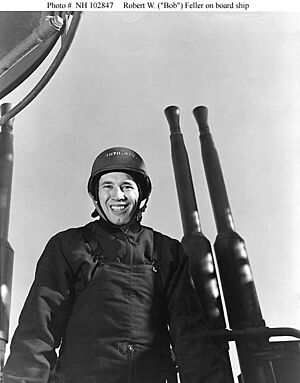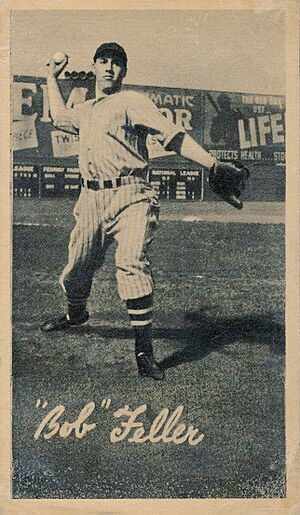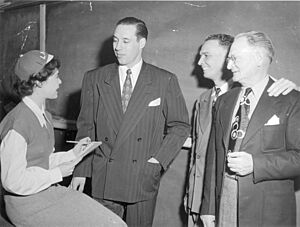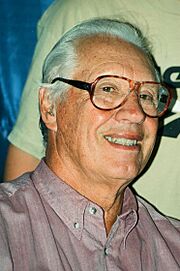Bob Feller facts for kids
Quick facts for kids Bob Feller |
|||||||||||||||||||||||
|---|---|---|---|---|---|---|---|---|---|---|---|---|---|---|---|---|---|---|---|---|---|---|---|
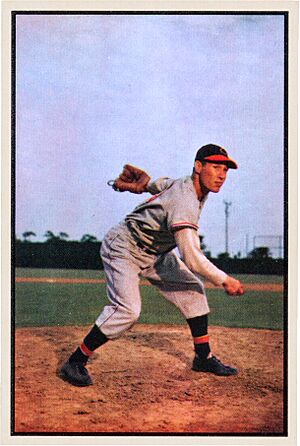
Feller with the Cleveland Indians, c. 1953
|
|||||||||||||||||||||||
| Pitcher | |||||||||||||||||||||||
| Born: November 3, 1918 Van Meter, Iowa, U.S. |
|||||||||||||||||||||||
| Died: December 15, 2010 (aged 92) Cleveland, Ohio, U.S. |
|||||||||||||||||||||||
|
|||||||||||||||||||||||
| debut | |||||||||||||||||||||||
| July 19, 1936, for the Cleveland Indians | |||||||||||||||||||||||
| Last appearance | |||||||||||||||||||||||
| September 30, 1956, for the Cleveland Indians | |||||||||||||||||||||||
| MLB statistics | |||||||||||||||||||||||
| Win–loss record | 266–162 | ||||||||||||||||||||||
| Earned run average | 3.25 | ||||||||||||||||||||||
| Strikeouts | 2,581 | ||||||||||||||||||||||
| Teams | |||||||||||||||||||||||
|
|||||||||||||||||||||||
| Career highlights and awards | |||||||||||||||||||||||
|
|||||||||||||||||||||||
| Induction | 1962 | ||||||||||||||||||||||
| Vote | 93.8% (first ballot) | ||||||||||||||||||||||
|
|||||||||||||||||||||||
Robert William Andrew Feller (November 3, 1918 – December 15, 2010) was an amazing American baseball pitcher. People called him "the Heater from Van Meter", "Bullet Bob", and "Rapid Robert" because he threw the ball so fast! He played for the Cleveland Indians in Major League Baseball (MLB) for 18 seasons, from 1936 to 1956.
During his career, Feller played in 570 games. He won 266 games and lost 162. He completed 279 games all by himself and pitched 44 shutouts, meaning the other team didn't score any runs. He also struck out 2,581 batters, which was the third-highest number ever when he retired!
Bob Feller was a true baseball star from a young age. He joined the Indians at just 17 years old, skipping the minor leagues. His career was paused for four years (1942–1945) while he served in the United States Navy during World War II. He was the first pitcher to win 24 games in a season before turning 21.
Feller threw three no-hitters in his career (1940, 1946, and 1951) and 12 one-hitters, which were records when he retired. He helped the Indians win the World Series in 1948. He also led the American League in wins six times and in strikeouts seven times. In 1946, he had 348 strikeouts, a huge number for that time.
He was an All-Star eight times. Many people, including Baseball Hall of Famers Ted Williams and Stan Musial, said he was one of the fastest and best pitchers they ever saw. In 1962, he was voted into the National Baseball Hall of Fame and Museum on his very first try. Feller also helped start the Major League Baseball Players' Association, which helps players. He passed away in 2010 at 92 years old.
Bob Feller: A Baseball Legend
Early Life and Amazing Start
Bob Feller grew up playing baseball, often as a shortstop or outfielder. When he was 15, he started pitching for his local team after their pitcher got hurt. He also played for his high school team and another amateur team, winning 19 games in one season. He was even the starting center for his high school basketball team!
By age 16, scouts from major league teams were already watching him because of his incredibly fast fastball. He was offered contracts by several teams, but he had already decided to sign with the Cleveland Indians.
Becoming a Teenage Star (1936–1941)
In 1936, a scout for the Indians, Cy Slapnicka, signed Feller for just one dollar and an autographed baseball. Slapnicka knew Feller was special, saying his fastball "would wiggle and shoot around."
Feller joined the Indians and made his MLB debut on July 19, 1936, at just 17 years old. A month later, in his first start, he struck out 15 batters, which was a record for a starting pitcher's debut. Three weeks later, he struck out 17 batters in one game, tying a record! He finished his first season with 5 wins and 3 losses. Bob Feller became so famous that the governor of Iowa greeted him when he returned home for high school.
In 1937, Feller was even on the cover of Time magazine. He graduated from high school in May, and the ceremony was broadcast on national radio!
In 1938, Feller set a new major league record by striking out 18 batters in a single game. He led all pitchers that year with 240 strikeouts.
The 1940 season started with a bang for Feller: he pitched a no-hitter against the Chicago White Sox on Opening Day! This is the only Opening Day no-hitter in MLB history. He finished that season with an amazing 27 wins and led the league in wins, ERA (2.61), and strikeouts (261). He also completed 31 games and pitched 320 innings.
To show how fast Feller's pitches were, baseball officials even had him pitch against a motorcycle! Feller's throw was measured at 98.6 miles per hour, and some later calculations even suggested it was over 100 mph.
In 1941, Feller again led the league in wins (25), strikeouts (260), and innings pitched (343). Joe DiMaggio, another baseball legend, said, "I don't think anyone is ever going to throw a ball faster than he does."
Serving His Country (1941–1945)
When the United States entered World War II after the attack on Pearl Harbor in December 1941, Bob Feller was the first American professional athlete to volunteer for the military. He joined the United States Navy just two days after the bombing.
Feller wanted to serve in combat, not just play baseball for the military. He was assigned to the battleship USS Alabama as a Gun Captain. He kept his arm strong by throwing near a gun turret. The Alabama served in both the Atlantic and Pacific Oceans, and Feller saw combat in November 1943 and during the Battle of the Philippine Sea.
He was discharged from the Navy in August 1945 as a Chief Petty Officer. He received six campaign ribbons and eight battle stars for his service. Feller later said, "The real heroes didn't come home."
Back to Baseball (1945–1948)
When Feller returned to Cleveland after the war, the city held a big parade for him. He pitched that same day against the Detroit Tigers and won the game. For the rest of the 1945 season, he had 5 wins and 3 losses.
In 1946, Feller pitched his second career no-hitter against the New York Yankees. He struck out 11 Yankees in that game. That season, he set career-highs in strikeouts (348), shutouts (10), and complete games (36). He finished with 26 wins and a very low ERA of 2.18.
Before the 1947 season, Feller organized a special tour where his team of major league players played against a team of Negro league stars like Satchel Paige. These games were very popular and helped show how talented the Negro league players were.
World Series Champion (1948)
The 1948 season was a great one for the Cleveland Indians. Feller had a record of 19 wins and 15 losses, and he led the league with 164 strikeouts. The Indians won the American League pennant for the first time since 1920!
Feller started Game One of the 1948 World Series against the Boston Braves. He pitched a great game, allowing only two hits, but the Indians lost 1-0. A controversial call by the umpire, who ruled a Braves player safe on a steal attempt when photos later showed he was out, led to the only run of the game. Even though Feller didn't win that game, the Indians went on to win the World Series, their second championship ever!
Later Years and Retirement (1949–1956)
In 1950, Feller reached 200 career wins, becoming the 53rd pitcher to do so. He continued to pitch well, showing his skill and experience.
On July 1, 1951, Feller pitched his third career no-hitter against the Detroit Tigers. He was only the third pitcher in history to achieve three no-hitters. That year, he won 22 games and was named the Sporting News Pitcher of the Year.
In 1954, the Indians had an amazing season, winning 111 games, which was an American League record at the time. Feller contributed with 13 wins and 3 losses. He earned his 250th career win and his 2,500th career strikeout that year.
Feller played his last major league game on September 30, 1956. He officially retired in December 1956. He spent his entire 18-season career with the Cleveland Indians. He was part of "The Big Four" pitching rotation in the 1950s, alongside Bob Lemon, Early Wynn, and Mike Garcia.
Bob Feller shares the Major League record for 12 one-hitters with Nolan Ryan. He was also the first pitcher to win 20 or more games before turning 21. He finished his career with 266 wins, 2,581 strikeouts, and 279 complete games. The Indians honored him by retiring his jersey number, 19, in 1956.
Hall of Fame and Legacy
In 1962, Bob Feller was elected to the National Baseball Hall of Fame and Museum, along with Jackie Robinson. They were the first players since the very first Hall of Fame class in 1936 to be elected on their first try.
Feller was known for his incredible pitching speed. While it's hard to measure exactly with old equipment, some estimates suggest his fastball reached over 100 miles per hour! Hall of Famer Ted Williams said he would think about Feller for three days before a game because he was so tough to hit.
The Sporting News ranked Feller 36th on their list of the 100 Greatest Baseball Players. Each year, American Legion Baseball gives out the "Bob Feller Pitching Award" to the pitcher with the most strikeouts in their competitions.
Later Life and Passing
After retiring from playing, Feller became the first president of the Major League Baseball Players' Association in 1956. He worked to help players get better rights, like the ability to become free agency and receive pensions.
Feller was also one of the first baseball stars to sign autographs at baseball events. Many people believe he signed more autographs than anyone else!
In June 2009, at 90 years old, Feller was one of the starting pitchers at the first Baseball Hall of Fame Classic game. He passed away on December 15, 2010, at the age of 92, due to complications from leukemia.
Remembering Bob Feller

After Feller's death, many people remembered him as a loyal player who stayed with the Cleveland Indians for his entire career. The "Cleveland Indians Man of the Year Award" was renamed the "Bob Feller Man of the Year Award" in his honor.
On Opening Day of the 2011 season, the Indians invited Feller's widow, Anne, to throw a silent first pitch. Players wore No. 19 jerseys and had an outline of Feller's pitching motion on their uniforms for the whole season.
The Bob Feller Museum opened in his hometown of Van Meter, Iowa, in 1995. It displayed many items from his career. In 2015, the museum was donated to the city and now serves as the city hall, but some of Feller's artifacts are still on display for visitors to see.
In 2013, the Bob Feller Act of Valor Award was created. This award honors people who show the same values, honesty, and dedication to serving their country that Bob Feller did.
Images for kids


